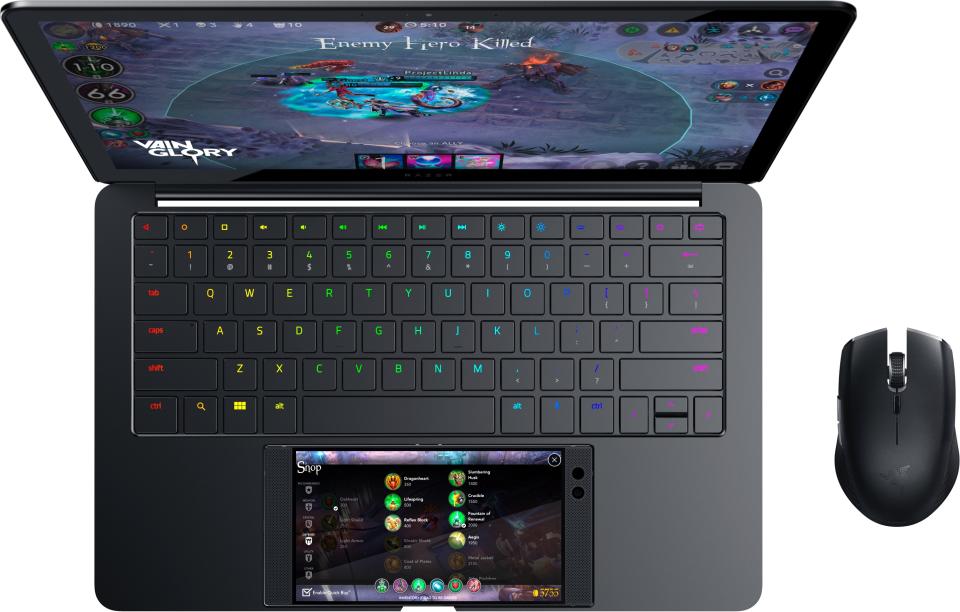Razer's Project Linda concept fuses a smartphone with a laptop
Gaming hardware maker Razer is known for rolling into CES every year and blowing the doors off the place with off-the-wall concepts. Last year it took the show by surprise by unveiling a three-screen laptop codenamed Project Valerie, and this year it’s doing the same with its smartphone-laptop hybrid codenamed Project Linda.
I got to check out Project Linda during a press event and while it’s not going to outpace a three-screen laptop for most over-the-top product, it’s certainly far likelier to result in an actual product.
Smartphone, meet laptop
Project Linda uses Razer’s own Android-powered Razor Phone and merges it with the shell of one of its Stealth laptops. Of course, Razer isn’t the first company that’s tried to merge a smartphone and computer into a single device. Smartphone makers have been developing laptop-style docks for their handsets for some time. But they’ve always failed to take off, as there was never a real reason to use a keyboard with your smartphone.
More recently, Samsung introduced its Dex adapter that turns your smartphone into a desktop computer. And while it works well in a pinch, it’s not going to give you the kind of power you need if you’re doing resource intensive work like photo or video editing, or managing large chunks of data.
Project Linda, though, isn’t meant to replace a laptop. Instead it’s meant to give you the option to play Android-based games with a keyboard and larger screen. Razer said it can also prove useful if you’re typing a particularly long email, or editing a document and need the screen real estate only a laptop can offer.
Gaming
The main draw of Project Linda, though, is to improve Android gaming. I played “Vainglory,” a multiplayer online battle arena-style game and it ran just as smooth on Linda’s screen as it did on the Razer Phone’s. I didn’t notice any issues with lag or slow down and the keyboard shortcuts worked just as they should.
I’m not a huge Android gamer, so Project Linda isn’t geared toward someone like me, but there are plenty of gamers out there that do most of their gaming on their Android phones. And a large number of them live in China.

One of the biggest games in the world is Tencent’s “Honor of Kings.” It boasts roughly 200 million players and was designed specifically for mobile users. Razer knows that the Chinese gaming market is huge and that mobile gamers occasionally want to play on larger screens, which is where Linda comes in.
How it works
Docking the Razer Phone with Project Linda is incredibly easy. You simply drop the handset into the slot where the Linda’s touchpad would be, and press the mechanical docking button on the keyboard. A USB C connector then slides into the phone’s port, and that’s that. Project Linda immediately begins displaying content from the Razer Phone on it’s screen.

Linda’s brains are all located in the Razer Phone, making the laptop portion a relatively dumb device. Of course, it also holds a large battery to charge the Phone when it begins to lose power.
Razer says you’ll be able to use the Razer Phone as either a touchpad for Project Linda, or a second screen for the computer, so you could be editing a photo and on Linda’s touchscreen and then select a second shot from your image library using the Razer Phone’s screen. Pretty slick.
When can you get it?
Since this is just a concept, Project Linda is nowhere close to becoming a real product. Everything Razer showed us was simply what they think they could one day produce. But for now there’s no talk of pricing, availability or any other relevant information. So for now, we’ll just have to wait and see if Razer can pull the trigger on this concept and make it a reality.
More from Dan:
The Blade Shadow could turn your phone into a Windows 10 gaming beast
There are reasons to be skeptical about Magic Leap’s long-awaited AR headset
Email Daniel Howley at [email protected]; follow him on Twitter at @DanielHowley.
